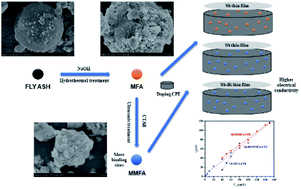Effects of modified fly ash doped carbon paste electrodes and metal film electrodes on the determination of trace cadmium(ii) by anodic stripping voltammetry†
Abstract
Fly ash, as waste from coal combustion, has been effectively modified to improve its adsorption to remove toxic metals, and modified fly ash could be used for electrode modification to improve the sensitivity of the electrode. In this paper, a modified fly ash doped carbon paste electrode for the detection of trace cadmium was first and successfully developed. Several parameters affecting the anodic stripping voltammetric response of Cd(II) were optimized, such as the composition of the paste, pH of the measurement solution, the concentration of Sb(III) (or Sb(III) and Bi(III)), deposition potential and deposition time. Compared with Sb/MFA-CPE, the square wave anodic stripping voltammetry (SWASV) response of Cd(II) at Sb/MMFA-CPE had a higher linear range and lower sensitivity. Relative to MFA, MMFA-CPE, due to the introduction of CTAB, provided a larger effective area for interacting with analytes, more binding sites and further facilitating electron transfer at the electrode, and amplified the electrochemical signal. Compared with Sb/MMFA-CPE, the SWASV response of Cd(II) at Sb–Bi/MMFA-CPE had a higher linear range and similar sensitivity, since mechanisms at bismuth and antimony film electrodes were different. Besides, the electrode reactions of Cd(II) at bismuth film electrodes involved adsorption phenomena while they were free of adsorption at antimony film electrodes.



 Please wait while we load your content...
Please wait while we load your content...